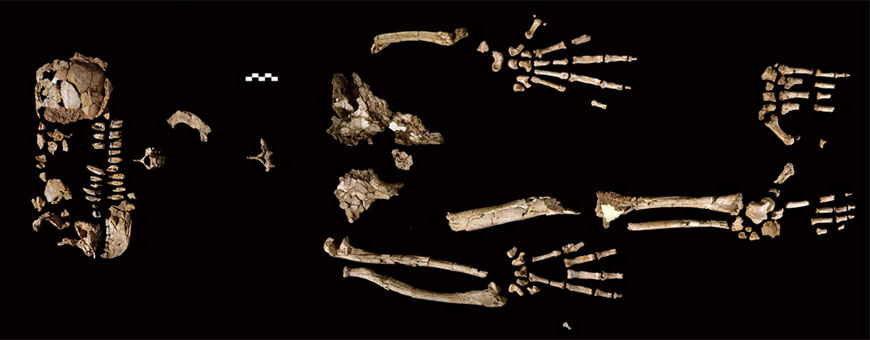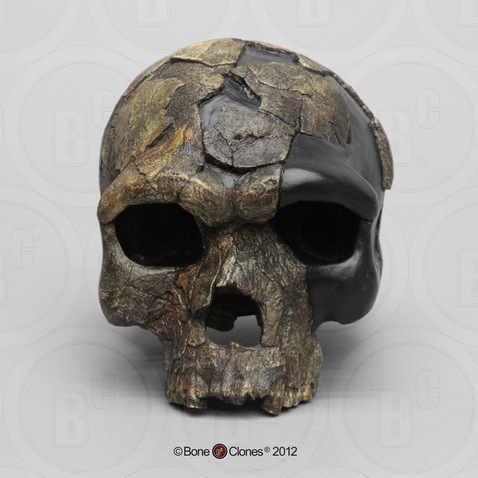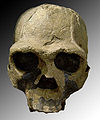Let us start at the beginning of our “bloodline.” I put bloodline in parenthesis because even though we can say with mild certainty this one is where we began the trek to becoming Homo sapiens sapiens, there is no way we could have access to their blood. Mostly because this evolutionary ancestor lived about 4.4 million years ago. This ancestor's name is Ardipithecus ramidus. Ardi (as the fossils of an almost complete skeleton, image below, are known) was amazing. She, of course, could climb trees, but had adapted to bipedal activity. But I am getting off blog topic. Ardi's name is very fitting to the first in our lineage. “Ardi” means “ground” or “floor,” “pithecus” means ape, but the meaning of “ramid” is perfect. “ramid” means “root.”
Next up is a combination, of which H. habilis should be part of but they are always put apart. H. habilis is one of three that are given the most credit to get us to where we are today; the other two are Homo ergaster, who lived between 1.9 and 1.4 million years ago, which not many people know of this one that said I am sure everyone know of the third one, which is given the species name of Homo erectus, who lived 1.9 million years ago. The reason, I think, all three are put together, most of the time seen as the same species, is because what they did is seen as the building blocks and vital to our evolution. With H. habilis using and making tools and H. erectus being the first one to walk exclusively on two feet, they might as well had been H. sapiens; but it was just a matter of their cranial capacity and skull shape. For H. ergaster the “ergaster” means “work,” so their species name really means “workman.” With H. erectus, “erectus” means “upright,” which makes sense seeing that they were the first to walk upright.
What is next is very exciting because it is just one step away from being human. The next Homo I will address is Homo heidelbergensis, who lived between 600,000 and 200,000 years ago. This one does not have any special meaning in their name. What I mean by this is the only reason they were named “heidelbergensis” is because they were found in the German city, Heidelberg; “heidelbergensis” is just a latinised version of the name. Now out of H. heidelbergensis came two subspecies; that of Homo sapiens idaltu and Homo sapiens neanderthalensis who lived between 500,000 and 10,000 years ago. Just like H. heidelbergensis, H. sapiens neanderthalensis is named after the location in which they were found in. The name of the location is Neander Valley in, once again, Germany. The German word for valley is “Tal,” but in the 1800's it was spelt “Thal (which is why some people pronounce Neanderthal with a “th” sound instead of a “t” sound).”
I know I said I was one step away from being human, and I really was...well am. Homo sapiens idaltu were almost modern human beings. They lived almost 160,000 years ago, and it was these first types of H. sapiens that interacted with the Neanderthals. “idaltu” is a Saho-Afar word meaning “elder of first born,” and “sapiens” from Latin meaning “wise.” Which gives H. sapiens idaltu the fitting name of “First born wise man.” Soon after H. sapiens idaltu, between 60,000 – 40,000 years ago, came us, Home sapiens sapiens, which means “Man wise wise.” The reason there is a distinction between H. sapiens idaltu and H. sapiens sapiens is because H. sapiens sapiens are also known as “Anatomically modern humans.”
You, at least those of you who are aware of our lineage, are wondering, “Where is the Cro-Magnon?” This is not really common knowledge but the Cro-Magnon, the second type of Homo sapiens that interacted with the Neanderthals, was us. The age of the first Cro-Magnon fossil that was found was about 30,000, a good 30,000 years after our species came into existence. It must have been terrifying but interesting to have been a Neanderthal, to be able to interact with and, in a way be witness to two types of Homo sapiens, last of which, would be the only one that survived. Those poor H. sapiens neanderthalensis.
Please feel free to comment on what you thought of the blog, or other physical anthropological subjects you would like me to cover.







 RSS Feed
RSS Feed
